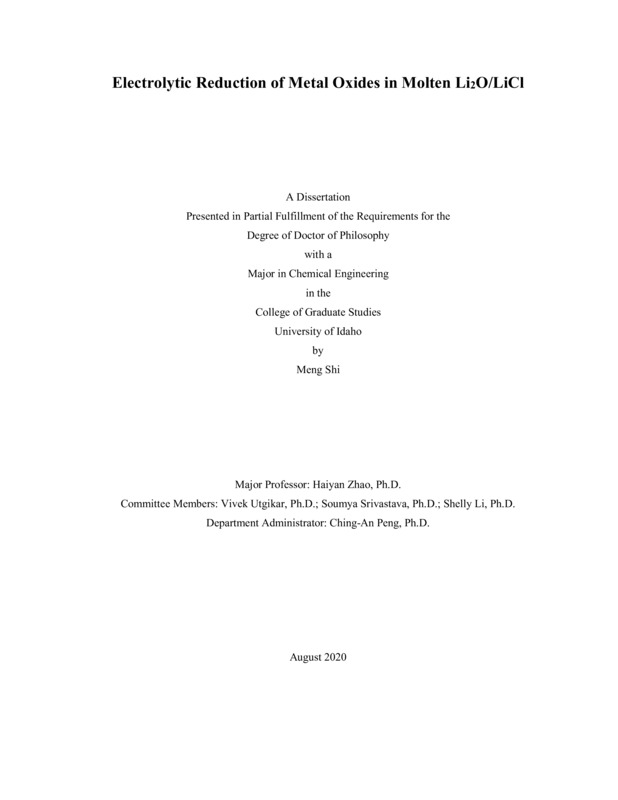Electrolytic Reduction of Metal Oxides in Molten Li2O/LiCl
Shi, Meng. (2020-08). Electrolytic Reduction of Metal Oxides in Molten Li2O/LiCl. Theses and Dissertations Collection, University of Idaho Library Digital Collections. https://www.lib.uidaho.edu/digital/etd/items/shi_idaho_0089e_11909.html
- Title:
- Electrolytic Reduction of Metal Oxides in Molten Li2O/LiCl
- Author:
- Shi, Meng
- ORCID:
- 0000-0002-0892-4828
- Date:
- 2020-08
- Embargo Remove Date:
- 2021-09-03
- Keywords:
- Electroreduction Li2O/LiCl molten salt NiO electroreduction Pseudo-Reference Electrode Sonication coupled electroreduction TiO2 electroreduction
- Program:
- Chemical and Materials Science Engineering
- Subject Category:
- Chemical engineering
- Abstract:
-
The electrolytic reduction of metal oxides is a promising approach for producing high purity metals. However, the commercialization of the process is challenged by low current efficiency. The low current efficiency is due to the slow oxygen ion diffusion through the oxide particles. In order to improve the current efficiency, it is important to understand the reduction mechanism and find solutions to the key factors.
This project focuses on fundamental electrolytic studies and the sonication operating mechanisms in molten salts. Metal oxides (NiO, and TiO2) were reduced in a small scale through electrolytic approaches in molten Li2O/LiCl at 650 °C. The reductions were carried out by controlling the total applied charges, and the cathodic potential at overpotentials and underpotentials. To accurately control the cathodic potential, a three-terminal electrolytic cell was used, including an oxide basket cathode, a glassy carbon crucible anode and a Ni/NiO reference electrode (RE). The reduced products are characterized for compositions and oxygen levels using X-ray diffraction (XRD) and Thermogravimetric Analysis (TGA). The XRD results were analyzed with the Rietveld refinement to get the concentration of the components. Salts after reductions were analyzed for metal element contents using Inductively Coupled Plasma Mass Spectrometry (ICP-MS). The reduction extent, current efficiency were calculated as the key parameters in evaluating the process.
Ni/NiO reference electrode was used in the reduction, due to its stable performance in electrolyte with varying O2- concentrations, compared with glassy carbon (GC), tungsten (W), and molybdenum (Mo) reference electrode. The correlation of the electrode potentials among the GC, W, Mo and Ni/NiO RE was defined in both molten LiCl and 1 w.t.% Li2O/LiCl. The lithium deposition potential measured with Ni/NiO reference electrode was -1.75 V ~ -1.95 V vs. Ni/NiO, based on the fabrication method of the Ni/NiO reference electrode.
In the overpotential reductions of NiO, Ni metal was produced at a high current efficiency of 96.1%. The reduction followed a one-step reduction mechanism and a fast kinetics. The NiO was reduced directly by the lithium metal and electrons without any intermediate involved. Samples were analyzed with XRD and TGA. The success in the NiO reduction verified the feasibility of the experiment setup and the methodology.
The reduction of TiO2 at overpotentials generated lithium titantes Li2TiO3 and LiTiO2. The reduction followed multiple steps and generate multiple interfaces. Li2TiO3 was formed on the outer shell of the particle through a spontaneous chemical combination reaction of TiO2 and Li2O. When the lithium metal was generated on the cathode, it reduced the TiO2 core to LiTiO2. Finally, the Li2TiO3 shell was reduced with Li metal to LiTiO2. LiTiO2 was the final product of the reduction at -0.3 V vs. Li/Li+ with 150% of theoretical charge, resulting in a 25% of reduction extent and 16.7% reduction extent. The oxygen ion diffusion through the solid phase was found to be the rate-limiting factor in the reduction.
The sonication was coupled with the TiO2 electroreduction process in both overpotential and underpotential controls. By using the ultrasound agitation, the current efficiency was improved. For overpotential reductions, the current efficiency was increased from 26.7% to 27.4%; and for the underpotential reductions, the increment was higher, from 36.7% to 44.5%. So, the introduction of sonication in the reductions can enhance the internal oxygen ion diffusion inside the metal oxides, and as the result, improve the current efficiency.
The results and conclusion in this work could promote the commercialization of the metal production through electrolytic reductions and ultrasound technique in molten salts, and impact the pyroprocessing technology for the treatment of spent nuclear fuels.
- Description:
- doctoral, Ph.D., Chemical and Materials Science Engineering -- University of Idaho - College of Graduate Studies, 2020-08
- Major Professor:
- Zhao, Haiyan
- Committee:
- Li, Shelly X.; Utgikar, Vivek; Srivastava, Soumya K
- Defense Date:
- 2020-08
- Identifier:
- Shi_idaho_0089E_11909
- Type:
- Text
- Format Original:
- Format:
- application/pdf
- Rights:
- In Copyright - Educational Use Permitted. For more information, please contact University of Idaho Library Special Collections and Archives Department at libspec@uidaho.edu.
- Standardized Rights:
- http://rightsstatements.org/vocab/InC-EDU/1.0/

